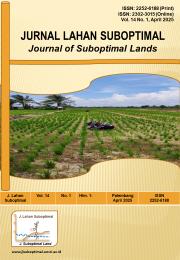Using the kriging method to establish a spatially reliable interpolator for peat depth variability
DOI:
https://doi.org/10.36706/jlso.14.1.2025.708Keywords:
good interpolator, Jambi, kriging analysis, peat depths, spatial variabilityAbstract
Peatlands (according to the Governmental Regulation nr 71/2014) can be utilized for agriculture and plantation if the peat depths are less than 3 m or more than 3 m, peatlands have to be conserved or restored. Determining peat depths can be conducted in the fields by intensive surveys which were so expensive, inefficient, and ineffective, therefore it was essential to find our simple alternative methods how to measure peat depths easily. The research aimed to establish a spatially reliable interpolator for peat depth variability by utilizing the kriging method. The research was conducted in Seponjen Village, Kumpeh, Muaro Jambi, Jambi Indonesia. Primary data were processed by applying ArcGIS 10.3 software. The interpolated dataset of peat depths validated their actual dataset and performed an excellent relationship (indicated by a positive correlation coefficient, r = 0.920) and a coefficient of determination (R2 = 0.847). It indicated that the interpolated dataset could be utilized to make maps by kriging. The very deep peat (Site A) and the deep peat (Site B) showed a tendency for a strong autocorrelation of the data distribution of peat depths. Autocorrelation tended to be anisotropic towards the river on the shallow peat (Site C). A good interpolator of peat depth variability can be generated using the kriging method.
References
Abijith, D., & Saravanan, S. (2021). Assessment of land use and land cover change detection and prediction using remote sensing and CA Markov in the Northern Coastal Districts of Tamil Nadu, India. Environmental Science and Pollution Research, 12(9), 86055‒86067. https://doi.org/10.1007/s11356-021-15782-6
Al-Timimi, Y. (2021). Monitoring desertification in some regions of Iraq using GIS techniques. Iraqi Journal of Agricultural Sciences, 52(3), 620‒625. https://doi.org/10.36103/ijas.v52i3.1351
Armanto, M. E. (2019a). Comparison of chemical properties of peats under different land uses in South Sumatra, Indonesia. Journal of Ecological Engineering, 20(5), 184‒192. https://doi.org/10.12911/22998993/105440
Armanto, M. E. (2019b). Improving rice yield and income of farmers by managing the soil organic carbon in South Sumatra Landscape, Indonesia. Iraqi Journal of Agricultural Sciences, 50(2), 653‒661. https://doi.org/10.36103/ijas.v2i50.665
Armanto, M. E. (2019c). Soil variability and Sugarcane (Saccharum officinarum L.) biomass along Ultisol toposequences. Journal of Ecological Engineering, 20(7), 196‒204. https://doi.org/10.12911/22998993/109856
Armanto, M. E., & Wildayana, E. (2022). Accessibility impacts to government programs on the household income contribution at the various livelihood sources of farmers. Agriekonomika Journal, 11(1), 62‒75. https://doi.org/10.21107/agriekonomika.v11i1.13191
Armanto, M. E., & Wildayana, E. (2023a). Predictive mapping for soil pH and phosphate based on Kriging Interpolation. International Conference on Sustainable Environment, Agriculture and Tourism (ICOSEAT), Advances in Biological Sciences Research, 26, pp. 254–262. https://doi.org/10.2991/978-94-6463-086-2_33
Armanto, M. E., Adzemi M. A., Wildayana, E. & Imanudin, M. S. (2013). Land evaluation for paddy cultivation in the reclaimed tidal lowland in Delta Saleh, South Sumatra, Indonesia. Journal of Sustainability Science and Management, 8(1), 32‒42.
Armanto, M. E., Hermawan, A., Imanudin, M. S., Wildayana, E., Sukardi & Triana, A. N. (2023a). Biomass and soil nutrient turnover affected by different peat vegetation. Journal of Wetlands Environmental Management, 11(1), 31‒42. http://dx.doi.org/10.20527/jwem.v11. i1.292
Armanto, M. E., Wildayana, E., & Syakina, B. (2023b). Deciphering the anthropogenic challenges of peat swamp forest degradation to improve awareness and emphasis on restoration in South Sumatra. Forestry Ideas, 29(2), 207–215.
Armanto, M. E., Zuhdi, M., Setiabudidaya, D., Ngudiantoro, Wildayana, E., Hermawan A., & Imanudin, M. S. (2022). Deciphering spatial variability and kriging mapping for soil pH and groundwater levels. Suboptimal Land Journal, 11(2), 187‒196. https://doi.org/10.36706/jlso.11.2.2022.577
Bhunia, G.S., Shit, P. K., & Chattopadhyay, R. (2018). Assessment of spatial variability of soil properties using the geostatistical approach of lateritic soil (West Bengal, India). Annals of Agrarian Science, 16(4), 436‒443. https://doi.org/10.1016/j.aasci.2018.06.003
Byg A., Novo, P. & Kyle, C. (2023). Caring for Cinderella - Perceptions and experiences of peatland restoration in Scotland. People Nature, 5, 302–312. https://doi.org/10.1002/pan3.10141
El Falah, S., Dakki, M., & Mansouri, I. (2021). Mapping analysis of the wetland loss in Loukkos (Morocco) under agricultural management. Bulgarian Journal of Agricultural Science, 27(1), 186–193.
Guth, M., Stępień, S., Smędzik-Ambroży, K., & Matuszczak, A. (2022). Is small beautiful? Technical efficiency and environmental sustainability of small-scale family farms under the conditions of agricultural policy support. Journal of Rural Studies, 89, 235‒247. https://doi.org/10.1016/j.jrurstud.2021.11.026
He, N., Yan, P., Liu, C., Xu, L., Li, M., Van Meerbeek, K., Zhou, G., Zhou, G., Liu, S., Zhou, X., Li, S., Niu, S., Han, X., Buckley, T. N., Sack, L., & Yu, G. (2023). Predicting ecosystem productivity based on plant community traits. Trends in Plant Science, 28(1), 43–53. https://doi.org/10.1016/j.tplants.2022.08.015
Holidi, Armanto, M. E., Damiri, N., & Putranto, D. D. A. (2019). Characteristics of selected peatland uses and soil moistures based on TVDI. Journal of Ecological Engineering, 20(4), 194‒200. https://doi.org/10.12911/22998993/102987
Hu, X., Zhang, P., Zhang Q., & Wang, J. (2021). Improving wetland cover classification using artificial neural networks with ensemble techniques. GIScience & Remote Sensing, 58(4), 603-623. https://doi.org/10.1080/15481603.2021.1932126
Imanudin, M. S., Armanto, M. E., & Bakri. (2019). Determination of planting time of watermelon under a shallow groundwater table in tidal lowland agriculture areas of South Sumatra, Indonesia. Irrigation and Drainage, 68(3), 488‒495. https://doi.org/10.1002/ird.2338
Jamali, A., Mahdianpari, M., Brisco, B., Granger, J., Mohammadimanesh, F., & Salehi, B. (2021). Wetland mapping using multi-spectral satellite imagery and deep convolutional neural networks: A Case study in Newfoundland and Labrador, Canada. Canadian Journal of Remote Sensing, 47(2), 243‒260. https://doi.org/10.3390/rs12132095
Junedi, H., Armanto, M. E., Bernas, S. M., & Imanudin, M. S. (2017). Changes to some physical properties due to the conversion of secondary forest of peat into oil palm plantation. Sriwijaya Journal of Environment, 2(3), 76‒80. http://ojs.pps.unsri.ac.id/index.php/ppsunsri/article/view/56
Lázaro-Lobo, A., & Ervin. G. N. (2021). Wetland invasion: a multi-faceted challenge during a time of rapid global change. Wetlands, 41(5), pp 64. https://doi.org/10.1007/s13157-021-01462-1
Lázaro-Lobo, A., Ruiz-Benito, P., Cruz-Alonso, V., & Castro-Díez, P. (2023). Quantifying carbon storage and sequestration by native and non-native forests under contrasting climate types. Global Change Biology, 29(16), 4530–4542. https://doi.org/10.1111/gcb.16810
Negassa W., Baum, C., Schlichting, A., Müller, J., & Leinweber P. (2019). Small-scale spatial variability of soil chemical and biochemical properties in a rewetted degraded peatland. Front. Environ. Sci, 7(116), 1‒15. https://doi.org/10.3389/fenvs.2019.00116
PMRA (Peat and Mangrove Restoration Agency). (2022). Performance report of peat and mangrove restoration agency. (p.113).
Syakina B., Nor, R. M., & Armanto, M. E. (2024a). Elucidating indigenous farmers’ avoidance of deep peatlands for food crop farming in South Sumatra province, Indonesia. Forestry Ideas, 30(1), 3‒15.
Syakina B., Nor, R. M., & Armanto, M. E. (2024b). Linkages of peatland degradation and rural poverty in development scenarios of peatland restoration. Geografia-Malaysian Journal of Society and Space, 20(1), 85‒98. https://doi.org/10.17576/geo-2024-2001-06
Varone, C., Lenti, L., Martino, S., & Semblat, J. F. (2021). Spatial variability of the urban ground motion in a highly heterogeneous site-city configuration. Bull Earthquake Eng, 19(1), 27‒45. https://doi.org/10.1007/s10518-020-00965-2.
Wildayana, E. (2017). Challenging constraints of livelihoods for farmers in the South Sumatra peatlands, Indonesia. Bulgarian Journal of Agricultural Science, 23 (6), 894–905.
Wildayana, E., & Armanto, M. E. (2017). Agriculture phenomena and perspectives of lebak swamp in Jakabaring South Sumatra, Indonesia. Jurnal Ekonomi dan Studi Pembangunan, 9(2), 156‒165.
Wildayana, E., & Armanto, M. E. (2018a). Dynamics of landuse changes and general perception of farmers on South Sumatra Wetlands. Bulgarian Journal of Agricultural Science, 24(2), 180‒188.
Wildayana, E., & Armanto, M. E. (2018b). Formulating popular policies for peat restoration based on the livelihoods of local farmers. Journal of Sustainable Development, 11(3), 85‒95. https://doi.org/10.5539/JSD.V11N3P85
Wildayana, E., & Armanto, M. E. (2018c). Lebak swamp typology and rice production potency in South Sumatra. Agriekonomika, 7(1), 30‒36. https://doi.org/10.21107/agriekonomika.v7i1.2513
Wildayana, E., & Armanto, M. E. (2018d). Utilizing non-timber extraction of swamp forests over time for rural livelihoods. Journal of Sustainable Development, 11(2), 52‒62. https://doi.org/10.5539/jsd.v11n2p52
Wildayana, E., & Armanto, M. E. (2021). Empowering indigenous farmers with fish farming on South Sumatra Peatlands. Jurnal HABITAT, 32(1), 1–10. https://doi.org/10.21776/Ub.Habitat.2021.032.1.1
Zhang, Y. (2023). Building a bridge between biodiversity and ecosystem multifunctionality. Global Change Biology, 29(16), 4456–4458. https://doi.org/10.1111/gcb.16729
Zhu, L., Liu, X., Wu, L., Liu, M., Lin, Y., Meng, Y., Ye, L., Zhang, Q. & Li, Y. (2021). Detection of paddy rice cropping systems in Southern China with time series landsat images and phenology-based algorithms. GIScience & Remote Sensing, 58(5), 733‒755. https://doi.org/10.1080/15481603.2021.1943214
Zuhdi, M., M. E. Armanto, D. Setiabudidaya, Ngudiantoro, & Sungkono. (2019). Exploring peat thickness variability using VLF method. Journal of Ecological Engineering, 20(5), 142‒148. https://doi.org/10.12911/22998993/105361
Downloads
Published
How to Cite
Issue
Section
License
Copyright (c) 2025 M Edi Armanto, Mohd Zuhdi, D Setiabudidaya, Ngudiantoro Ngudiantoro, Elisa Wildayana

This work is licensed under a Creative Commons Attribution-NonCommercial-ShareAlike 4.0 International License.













